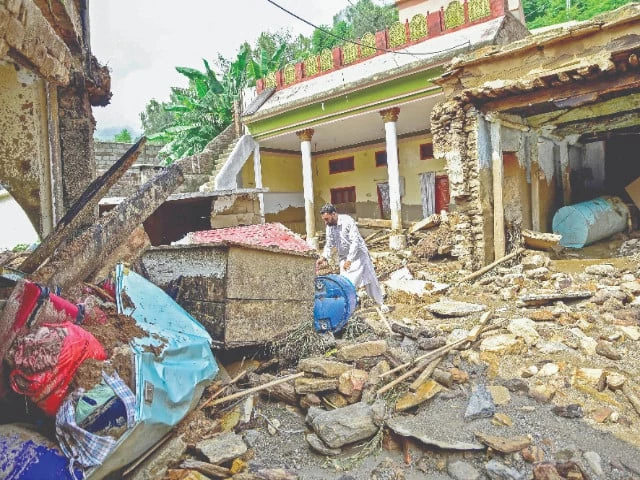PESHAWAR:
Rescuers in flood-ravaged Khyber-Pakhtunkhwa (K-P) districts clawed through mud and debris on Saturday as flash floods unleashed by days of heavy monsoon rains killed at least 344 people in the province within 48 hours, officials said.
The National Disaster Management Authority (NDMA) confirmed that 324 of the deaths were reported in K-P, with dozens more killed in Azad Jammu and Kashmir and Gilgit-Baltistan. At least 137 people were injured as homes collapsed and torrents of water swept away residents, livestock and vehicles.
Officials said the scale of the devastation forced the provincial government to declare six districts — Buner, Bajaur, Swat, Shangla, Mansehra and Battagram — disaster-hit. Thousands of homes were destroyed and key roads, including bridges and link routes, were washed away, complicating rescue and relief operations.
“Heavy rainfall, landslides and washed-out roads are severely hampering rescue efforts, particularly the transportation of heavy machinery and ambulances,” said Bilal Ahmed Faizi, spokesman for K-P’s rescue agency.
“In some areas, workers are forced to walk long distances to reach disaster sites,” he said. “They are trying to evacuate survivors, but very few people are relocating due to the deaths of their relatives or loved ones being trapped in the debris.”
Buner’s district deputy commissioner Kashif Qayum Khan also said rescuers were forced to find new ways to reach remote areas. “Many more people may still be trapped under the debris, which local residents cannot clear manually,” Khan told AFP.
Nearly 2,000 rescue personnel have been deployed, but officials warned that many victims may still be trapped under rubble in remote villages.
In Shangla district alone, officials confirmed 37 deaths, with several people still missing. Torrential floods, lightning strikes and landslides left hundreds injured, flattened houses and displaced entire communities.
Eleven more people were killed in AJK, and another nine in G-B, officials said. Five more were killed when a local government helicopter crashed due to bad weather during a relief mission in Bajaur district on Friday.
The meteorological department has also issued a heavy rain alert for northwestern regions, urging people to take “precautionary measures”.
Syed Muhammad Tayyab Shah of NDMA told AFP that this year’s monsoon season began earlier than usual and was expected to end later. It would also increase in intensity over the next fortnight, he added.
In Buner, an AFP journalist saw three excavators clearing mud and wood from the completely flattened site, while dozens of rescuers and residents also dug through the debris.
Others cleared heavy rocks with their hands and with shovels. “People are still lying under the debris… Those who were swept away are being searched for downstream,” said resident Abdul Khan.
Floodwaters also destroyed livestock, shops and vehicles, while key roads including AlpuriBisham, AlpuriPuran and AlpuriChakesar were badly damaged. Though some were temporarily reopened on Saturday, access to remote areas remains cut off.
Residents told of funerals being held in devastated villages, where survivors continue to search through rubble by hand. “I helped retrieve the bodies of children I taught,” said Saifullah Khan, a schoolteacher in Buner. “The trauma is unbearable.”
Another villager in Buner told AFP residents kept on searching through the rubble overnight.
“The entire area is reeling from profound trauma,” said 32-year-old schoolteacher Saifullah Khan. “I help retrieve the bodies of the children I taught, I keep wondering what kind of trial nature has imposed on these kids,” he said.
The NDMA said torrential monsoon rains across Pakistan have killed more than 650 people so far this season, with 905 injured. The agency warned that the downpours, which began earlier than usual this year, are expected to continue with greater intensity over the next fortnight.
Monsoon floods in South Asia bring much of the region’s annual rainfall, vital for agriculture but devastating when extreme. Pakistan, among the countries most vulnerable to climate change, has faced increasingly frequent and intense weather events. In 2022, floods submerged a third of the country and killed around 1,700 people.
Provincial authorities said relief operations are under way, with heavy equipment being moved to clear roads and restore connectivity. The PDMA chairman visited Shangla on Saturday, urging officials to accelerate aid and rehabilitation.
The K-P chief minister is expected to visit flood-stricken areas on Sunday to review damage and announce further measures.
The torrential rains that have pounded Pakistan since the start of the summer monsoon, described as “unusual” by authorities, have killed more than 650 people, with more than 905 injured.
In July, Punjab recorded 73 per cent more rainfall than the previous year and more deaths than in the entire previous monsoon.
Pakistan is one of the world’s most vulnerable countries to the effects of climate change and is contending with extreme weather events with increasing frequency. Monsoon floods in 2022 submerged a third of the country and killed around 1,700 people.
(With additional input from agencies)

